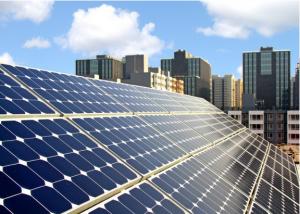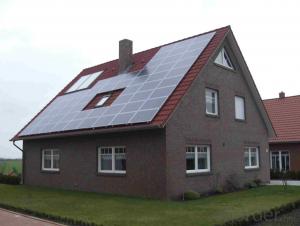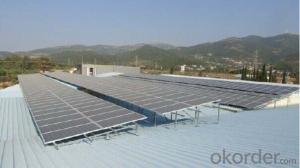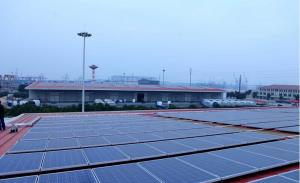Complete Solar System for Home Solar Panel System Home 5KW
- Loading Port:
- Guangzhou
- Payment Terms:
- TT or LC
- Min Order Qty:
- 10 set
- Supply Capability:
- 100000 set/month
OKorder Service Pledge
OKorder Financial Service
You Might Also Like
Complete Solar System for Home Solar Panel System Home 5kw
Features of Complete Solar System
Solar module:solar battery module(also called photovoltaic battery module)in series or in parallel according to the system requirements,the solar energy will change into electrical energy in the light of the sun and then output,it is the core component of solar photovoltaic system.
Controller: solar power controller is an important part of the solar power system, System of charging and discharging and load work automatically by its intelligent control and protection. Its performance directly affects the reliability of the system. Especially the battery life, overcharge or over discharge will be cause damage and even lethal damage for the battery.
Inverter: in solar photovoltaic power supply system, if it has the AC load, it is necessary to use the devices of the inverter. The direct current generated by solar modules or the battery release of DC into AC for load.
Battery:Stored up the electricity produced by the solar cell module produce,When illumination is insufficient or night or load demand is greater than the power produced by the solar cell module.Stored energy will be released in order to meet the load demand of energy,It is the solar energy photovoltaic system energy storage unit.Currently solar pv system commonly used is lead acid battery,For higher requirements of the system,Usually adopt deep discharge vrla battery ,deep discharge suction fluid type lead-acid battery,etc
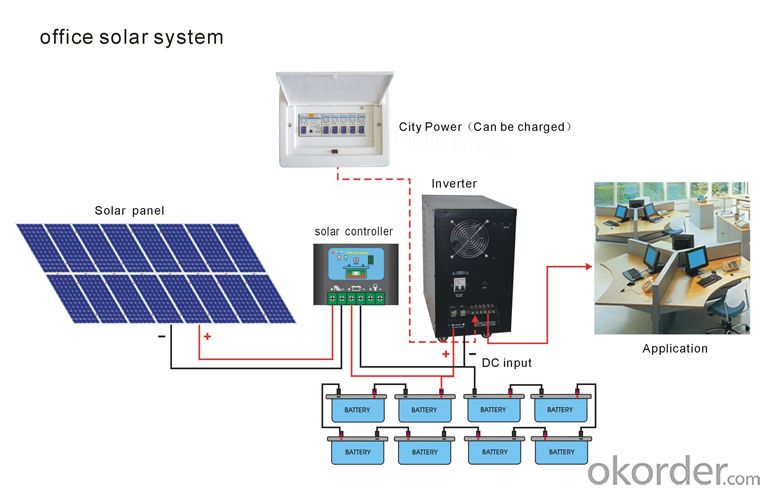
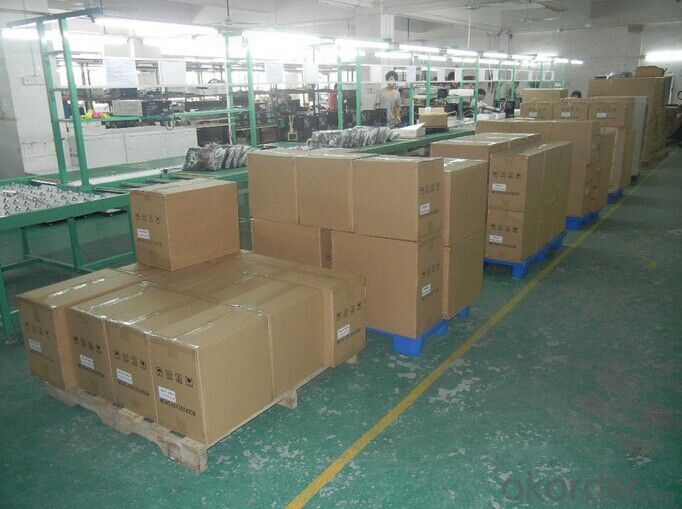
Product Parameter
Model XD- | TNY50112-10 | TNY70112-50 | TNY10224-50 | TNY20248-40 | TNY50296-50 | |||
Solar Energy Module | Type | Monocrystalline silicon A level | ||||||
Power | 100W | 500W | 1100W | 1800W | 4400W | |||
Daily Power generation | 0.5KWH | 2.5KWH | 5.5KWH | 9KWH | 22KWH | |||
Size(mm) | 1160×660×35×1 | 1250*660*35*4 | 1360*900*40*6 | 1620*990*40*8 | 1955*990*45*16 | |||
PV Controller | Control mode | Direct charge/PWM/MPPT | ||||||
Charge current | 10A | 50A | 50A | 40A | 50A | |||
Rated charging voltage | 12VDC | 12VDC | 24VDC | 48VDC | 96VDC | |||
Compulsive charging voltage | 14.8V | 29.6V | 59.2V | 118.4V | ||||
Balanced charging voltage | 14.4V | 28.8V | 57.6V | 115.2V | ||||
Floating charging voltage | 13.8V | 27.6V | 55.2V | 110.4V | ||||
Recovery charging voltage | 13.3 | 26.6V | 53.2V | 106.4V | ||||
Battery overvoltage protection/recovery | 16.5V/15V | 33V/30V | 66V/60V | 132V/120V | ||||
Protection function | Reverse connection, short circuit, overcharge, anti charge protection | |||||||
Display | LED | |||||||
PV Inverter | Rated Capacity | 500W | 700W | 1000W | 2000W | 5000W | ||
DC voltage | 12V | 24V | 48V | 96V | ||||
Undervoltage protection | 10.5V | 21V | 42V | 84V | ||||
Inverter structure | Low frequency structure | |||||||
Mains input | 75VAC-125VAC or 145VAC-275VAC | |||||||
Inverter output | 110VAC+/-2% or 220VAC+/-2% | |||||||
Mains input charging current | 10A | |||||||
Working way | Mains priority/solar power priority (optional) | |||||||
Conversion time | ≤4ms | |||||||
Overload capacity | Overload 110% 30 seconds the machine automatically shut down; overload shutdown 120% 2 seconds; mains mode overload do not shutdown | |||||||
Conversion efficiency | ≥80% | |||||||
Output waveform | Pure sine wave | |||||||
Work environment | Temperature0-40℃,Humidity10-90% | |||||||
Cooling mode | Forced air cooling | |||||||
Protection function | Mains over / under-voltage, direct current is too high / undervoltage, the inverter output short circuit | |||||||
Display | LCD | |||||||
Output waveform distortion | ≤±0.3% | |||||||
Input and output frequency | The same with power system | |||||||
Battery | Battery Type | Deep cycle maintenance-free lead-acid battery | ||||||
Battery capacity | 100AH/12V×1 | 200AH/12V×1 | 100AH/12V×2 | 200AH/12V×4 | 100AH/12V×8 | |||
Discharge time(full Load calculation) | 1.3H | 1.8H | 1.3H | 2.8H | 1.1H | |||
Machine specifications | Size(mm) | 465×245×465 | 580×280×470 | 580×300×610 | 600×540×940 | |||
Weight | 48KG | 81KG | 7KG | 302KG | 332KG | |||
Remarks | Specification for reference.Subject to change without prior notice | |||||||


- Q:What is the impact of temperature on the efficiency of a solar energy system?
- The temperature greatly affects the efficiency of a solar energy system. As the temperature rises, the efficiency of solar panels decreases. This is because of how the semiconductor materials used in solar cells behave. When solar panels are exposed to sunlight, they absorb photons and convert them into electricity. However, as the temperature increases, the resistance of the semiconductor material also increases, which leads to a decrease in the flow of current. This phenomenon is called the temperature coefficient of power. The temperature coefficient of power is usually expressed as a percentage per degree Celsius and varies depending on the type of solar panel technology. Most solar panels have a negative temperature coefficient, meaning their efficiency decreases as the temperature rises. On average, solar panel efficiency can decrease by around 0.5% to 0.8% for every degree Celsius increase in temperature. Moreover, increased temperatures can cause thermal losses within the system. The heat can accumulate in the solar panels, further reducing their efficiency. This is particularly true in hot climates or when there is high solar irradiance. To address the impact of temperature on solar energy system efficiency, various strategies can be employed. One common approach is to incorporate cooling mechanisms, such as ventilation or water circulation, to dissipate the excess heat generated by the solar panels. This helps maintain lower operating temperatures and consequently improves overall efficiency. Furthermore, proper system design and installation techniques can also reduce temperature-related losses. For instance, mounting solar panels with sufficient spacing to allow for air circulation can prevent overheating. Additionally, choosing solar panels with lower temperature coefficients can help minimize efficiency losses in high-temperature environments. In conclusion, temperature significantly affects the efficiency of a solar energy system. Higher temperatures can cause a decrease in solar panel efficiency, mainly due to increased resistance in the semiconductor materials. To optimize the performance of solar energy systems, strategies like cooling mechanisms and proper system design should be implemented.
- Q:Can solar energy systems be used for powering remote sensing or surveillance equipment?
- Yes, solar energy systems can be used for powering remote sensing or surveillance equipment. Solar panels can be installed to capture sunlight and convert it into electricity, which can then be used to power the equipment. This is particularly useful in remote locations where access to traditional power sources may be limited or unavailable. Additionally, solar energy systems are often considered more sustainable and cost-effective in the long run compared to using fossil fuels or relying on batteries for power.
- Q:What is the role of maximum power point tracking (MPPT) in a solar energy system?
- The role of maximum power point tracking (MPPT) in a solar energy system is to maximize the efficiency and output of the system by continuously adjusting the operating point of the solar panels to ensure they are operating at their maximum power point. This is important because the power output of solar panels is highly dependent on environmental factors such as temperature and sunlight intensity. MPPT algorithms track these variations and optimize the power output by adjusting the voltage and current to match the maximum power point. By doing so, MPPT increases the overall energy generation and improves the performance of the solar energy system.
- Q:Are there any risks of electrical hazards during installation or maintenance of solar energy systems?
- Yes, there are risks of electrical hazards during the installation or maintenance of solar energy systems. Solar energy systems involve working with high-voltage DC (direct current) electricity, which can pose dangers if not handled properly. Some of the potential risks include: 1. Electrocution: Solar panels generate electricity, and if not isolated or disconnected properly, there is a risk of electrocution for individuals working on the system. 2. Fire Hazards: Faulty wiring, loose connections, or improper installation can lead to electrical arcs and sparks, which can ignite a fire if proper precautions are not taken. 3. Falls and Injuries: Solar panels are typically installed on rooftops, which may involve climbing ladders, working at heights, and handling heavy equipment. If not done with caution, it can result in slips, falls, or injuries. 4. Arc Flash: When working on live electrical equipment, there is a risk of arc flash, which is a sudden release of energy that can cause severe burns, hearing damage, and even death. 5. Environmental Risks: While not directly related to electrical hazards, it is essential to consider potential environmental risks during the installation of solar energy systems. For instance, improper disposal of hazardous materials used in solar panels, such as lead, cadmium, or other toxic substances, can harm the environment if not handled correctly. To mitigate these risks, it is crucial to follow proper safety protocols and guidelines during the installation and maintenance of solar energy systems. This includes wearing personal protective equipment (PPE), ensuring proper grounding and isolation procedures, using insulated tools, and following all local electrical codes and regulations. It is also recommended to hire trained and certified professionals for the installation and maintenance to minimize the risks associated with electrical hazards.
- Q:Can solar energy systems be used for outdoor lighting?
- Yes, solar energy systems can be used for outdoor lighting. Solar-powered outdoor lighting systems use solar panels to capture sunlight and convert it into electricity, which is stored in batteries. This stored energy is then used to power outdoor lights during the night. Solar-powered outdoor lighting is a sustainable and cost-effective solution that eliminates the need for traditional electrical wiring and reduces carbon emissions.
- Q:Can solar energy systems be used for powering remote weather stations?
- Yes, solar energy systems can definitely be used for powering remote weather stations. Solar energy is a clean and renewable source of power that can be harnessed in remote areas where connecting to the electrical grid might not be feasible or cost-effective. Weather stations require a continuous supply of electricity to operate their sensors, data loggers, communication devices, and other equipment. Solar panels can be installed at these stations to capture sunlight and convert it into electricity through photovoltaic technology. This electricity can then be stored in batteries, providing a reliable and sustainable power source for the weather station even during cloudy or nighttime conditions. Additionally, solar energy systems require minimal maintenance and have a long lifespan, making them ideal for remote locations where regular maintenance visits may be challenging. Overall, using solar energy systems for powering remote weather stations is a practical and environmentally friendly solution that can ensure the continuous operation of these vital monitoring facilities.
- Q:Are there any disadvantages of solar energy systems?
- Although solar energy systems offer numerous advantages, they also have a few drawbacks. One major disadvantage is the high initial installation cost, which can be unaffordable for certain individuals or businesses due to the substantial expenses associated with purchasing and setting up solar panels. Moreover, external factors such as weather conditions, shading, and panel angles can affect the efficiency of solar panels, limiting their effectiveness in specific locations. Another drawback is the intermittent nature of solar power, as it can only be generated during daylight hours and is unavailable during cloudy or nighttime conditions. This necessitates the installation of costly battery systems for energy storage or reliance on the grid during non-generating periods. Lastly, the production of solar panels requires the use of certain materials, some of which are non-renewable and can have negative environmental impacts during the extraction and manufacturing processes. Nonetheless, advancements in technology and decreasing costs are continually enhancing the efficiency and affordability of solar energy systems.
- Q:Can solar energy systems be used in powering electric fences or security systems?
- Yes, solar energy systems can be used to power electric fences or security systems. Solar panels can convert sunlight into electricity, which can then be stored in batteries and used to power these systems. This provides a reliable and sustainable source of energy, especially in remote areas where access to conventional power sources may be limited. Additionally, solar-powered systems are cost-effective and environmentally friendly, making them an ideal choice for powering electric fences and security systems.
- Q:Can a solar energy system be installed on a building with a metal roof?
- Yes, a solar energy system can be installed on a building with a metal roof. In fact, metal roofs are often considered ideal for solar installations due to their durability and longevity. Installing solar panels on a metal roof is typically easier and more cost-effective compared to other roofing materials. Metal roofs provide a stable platform for mounting the solar panels and can withstand the weight and weather conditions associated with solar installations. Additionally, metal roofs are often more reflective, which can increase the efficiency of the solar panels by reducing heat absorption. Overall, a metal roof is a great option for installing a solar energy system on a building.
- Q:Can solar energy systems be used for air conditioning?
- Yes, solar energy systems can be used for air conditioning through the use of solar-powered air conditioning units or by using solar energy to power traditional air conditioning systems.
1. Manufacturer Overview |
|
|---|---|
| Location | |
| Year Established | |
| Annual Output Value | |
| Main Markets | |
| Company Certifications | |
2. Manufacturer Certificates |
|
|---|---|
| a) Certification Name | |
| Range | |
| Reference | |
| Validity Period | |
3. Manufacturer Capability |
|
|---|---|
| a)Trade Capacity | |
| Nearest Port | |
| Export Percentage | |
| No.of Employees in Trade Department | |
| Language Spoken: | |
| b)Factory Information | |
| Factory Size: | |
| No. of Production Lines | |
| Contract Manufacturing | |
| Product Price Range | |
Send your message to us
Complete Solar System for Home Solar Panel System Home 5KW
- Loading Port:
- Guangzhou
- Payment Terms:
- TT or LC
- Min Order Qty:
- 10 set
- Supply Capability:
- 100000 set/month
OKorder Service Pledge
OKorder Financial Service
Similar products
New products
Hot products
Related keywords

